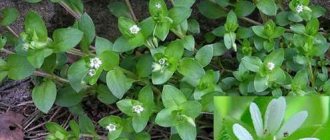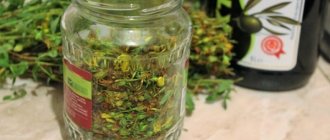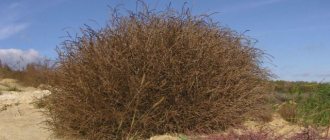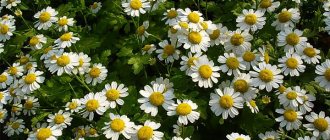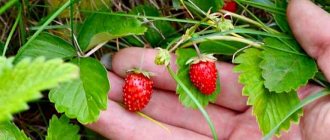Veronica officinalis herb photo and description
Veronica officinalis L. is a perennial herbaceous plant 15–30 (up to 50) cm high with creeping, rooting, pubescent shoots ascending upward. The leaves are opposite, oblong, pubescent on both sides, 1.5–4 cm long, 1–2 cm wide, narrowed at the base into short wide petioles.
The flowers, pale lilac or bluish, sometimes white, with a four-parted calyx and a four-petalled corolla, are collected in inflorescences - brushes in the axils of the upper leaves at the tops of the stems. Blooms from June to September. The fruits are flattened multi-seeded, two-locular capsules that ripen from July to October. Propagated by seeds and vegetatively.
The plant is distributed throughout the European part of Russia, Crimea, and the Caucasus. It grows in clearings, meadows, forest edges, light forests, forest ravines, in the mountains up to the subalpine zone. In open areas, edges, and clearings, it forms a continuous carpet of intertwined stems.
For medicinal purposes, the herb is used - above-ground shoots. They are carefully cut so as not to damage the root, with leaves and flowers at the beginning of flowering. Dry at a temperature of 35 - 40 ° C, paying attention that the flowers do not change color or fall off. The dried raw materials have a pleasant, faint odor and a tart, bitter taste; the shelf life is 2 years.
The beneficial properties are due to the rich chemical composition of the plant.
The herb contains glycosides 0.5 - 1.2% - catallol, aucubin, veronicoside, minecoside and others, sterols, saponins, essential and fatty oils, bitterness, tannins about 0.6%, flavonoids - apigenin, luteolin, cynaroside, nitrogen-containing compounds, choline, coumarins, organic acids - lactic, tartaric, acetic, citric, malic, phenolcarboxylic acids and their derivatives, carotene, vitamin C.
Composition of Veronica officinalis
In total, there are more than 150 species of Veronica, but the composition of the herb Veronica officinalis is the richest in various nutritional and medicinal components. It is not for nothing that people affectionately call it treasure, heart grass and pharmaceutical oubrovka. The chemical composition of the plant will include:
- carbohydrates
- many organic and phenolcarboxylic acids
- essential oils
- alkaloids and iridoids
- sterols
- saponins
- choline
- coumarins
- bitterness and tannins
- fixed oils
- bioflavonoids
- several vitamins, including vitamins “C”, “A”
Useful properties and contraindications
The herb Veronica officinalis has anti-inflammatory, analgesic, hemostatic, expectorant and wound-healing effects.
Previously, the plant was widely used in scientific medicine in Russia; now it is used mainly for diseases of the upper respiratory tract and bronchial asthma.
The herb is used in official medicine in Western Europe. In Germany, it is used in the form of tea for respiratory and gastrointestinal diseases, especially diarrhea. In Austria, a decoction is used to treat tracheitis, bronchitis, skin itching in diabetes, and in the treatment of gout.
In Rus', it has long been used for acute diseases of the upper respiratory tract, bronchitis and bronchial asthma, pulmonary tuberculosis, gastrointestinal diseases - decreased appetite, gastritis with low acidity of gastric juice, and diarrhea.
It was used as a diuretic for diseases of the urinary tract and gout, used for rheumatism, diabetes, malignant neoplasms, gynecological diseases, as a hemostatic agent for external and internal bleeding; used for bites of vipers and rabid animals.
Prepared infusion:
1. Pour two tablespoons of dry crushed herbs into 0.5 liters of boiling water, cover, leave for 2 hours, strain. Take in 3-4 doses 20-30 minutes before meals.
The infusion has a strong emollient and expectorant effect, increases appetite, and is used as an anti-inflammatory, analgesic, antiseptic, antitoxic and fungicidal agent.
Externally, the infusion was used for burns, purulent wounds, furunculosis, chronic skin diseases, and sweating of the feet.
The plant was used for eczema, urticaria, neurodermatitis, insomnia, nervous exhaustion, various types of itching, fungal diseases, pyodermatitis.
At the same time, the following infusion was recommended:
2. Pour three teaspoons of dry herb into 3 cups of boiling water, leave covered for 20 - 30 minutes, strain. Take a glass 3 times a day after meals.
The calming properties of the plant are used for headaches, insomnia, and increased nervous excitability, especially during menopause.
For kidney diseases and gout, the juice of fresh Veronica herb is useful:
Take 2 - 3 teaspoons of juice in the morning 20 - 30 minutes before meals, during the summer season.
For chronic pyelonephritis:
Two tsp. Mix herb juice with 1 tbsp. l. goat milk. Take the resulting mixture 2 times a day before meals.
Preparation of alcohol tincture:
Fresh juice can be preserved by preparing an alcohol tincture:
Pour 100 ml of grass juice into 200 ml of vodka, leave in a dark place for 10 days, then strain.
The tincture can be used both pure and diluted, like juice.
It can be used externally to lubricate fungal infections of the skin and scalp.
Preparation and use of oil:
Freshly harvested herbs are infused in an equal weight amount of vegetable oil for 10 days, then the oil is drained and filtered. Used topically for skin burns, festering wounds and boils.
For neurodermatitis and eczema, an ointment was prepared:
Grind 1 part fresh herb with 4 parts pork fat, lubricate the damaged areas.
Veronica has antimicrobial, fungicidal, hemostatic, wound-healing effects, so it is used for external treatment of wounds and skin diseases.
For purulent wounds, ulcers, acne, itchy rashes, and fungal skin infections, baths, rinses, compresses, and lotions are made from the infusion.
Fresh, well-crushed leaves are applied to purulent wounds and ulcers.
In folk medicine, several types of veronica herb are used, which have similar medicinal properties. They belong to the same genus, but are very different in appearance.
Preparing tea:
20 g of herb (2 - 3 tablespoons) are brewed with a liter of boiling water. Drink this dose during the day for all types of skin diseases, eczema, scrofula, gout and rheumatism.
Tea is drunk as a mild diuretic, for sand in the kidneys and bladder, for respiratory diseases, as a good expectorant and thinner for thick mucus.
Let's consider other medicinal species - oak speedwell and longleaf speedwell.
Properties and uses of Veronica officinalis
Such a modest plant, which can be seen in the photo of Veronica officinalis, has pronounced pharmacological properties to reduce any pain, inflammation, stop bleeding, and heal wounds. In addition, veronica raw materials are an excellent diuretic, expectorant, and choleretic agent.
Veronica infusion can increase appetite, fights gastritis, ulcers, colitis and diarrhea, is a good expectorant, helps to quickly remove mucus from bronchitis, and treat bronchial asthma. Speedwell is popular both in folk medicine and among homeopaths: in the latter case, the juice and essence of the plant are more widely used.
As an anesthetic, infusions and decoctions based on the herb Veronica officinalis are effective for headaches and abdominal pain. The plant has found its use in neurology as a medicine for insomnia, nervous exhaustion, and increased excitability. In gynecology, taking Veronica is popular as a method of folk treatment for discomfort during menopause and inflammation, in dermatology - for scabies, scrofula, dermatitis, eczema, non-healing wounds, boils, fungal skin diseases (especially for mycoses of the legs). Veronica raw materials are also suitable for the rapid resorption of hematomas and abrasions, for the treatment of gout, arthrosis, hernias, kidney diseases, and rheumatism. Experienced folk healers recommend including Veronica decoctions in a set of measures against tuberculosis, urolithiasis and even stomach cancer.
Veronica Dubravnaya photo and description
Veronica oak grove Veronica chamaedrys L. is a perennial herbaceous plant 10–40 cm high with a creeping rhizome and ascending or erect stems. Bright blue flowers are collected in opposite clusters of few flowers in the axils of the upper pair of leaves. Blooms from late May to August.
Grows on forest edges, glades, steppe slopes. The plant has adapted to the lack of moisture; it waters itself, using all the moisture that falls on it. Its leaves are opposite, the hairs on the stem are arranged so that when water hits the leaf, it runs down the hairs towards the root.
If under other plants it is sometimes dry even after a heavy downpour, then under Veronica oak grove it is always wet and humid even after any light rain.
The species name chamaedrys comes from the Greek words chamai - low and drys - oak, named after the main places where the plant grows.
Veronica longifolia
Veronica longifolia L. is the tallest type of grass. It grows along the banks of rivers and lakes, along roadsides almost throughout the country. A perennial plant with a long root and a densely leafy, erect stem, branched only in the upper part, 40–120 cm high, with long, oblong-pointed leaves.
It blooms with long narrow dense inflorescences - dark blue tassels from June to August. The plant is called St. Andrew's cross because of its appearance - the central raceme is usually larger than the side ones. The upper part of the stem with leaves and flower clusters is used and dried in bunches. It produces up to 10,000 seeds, which, falling to the ground, remain viable for several years.
The scientific species name longifolia, translated from Latin, means long-leaved, characterizes the peculiarity of the plant species.
Herbs in medicinal plant collections
The herb is part of effective medicinal preparations and breast tea.
Veronica, like the series, is one of the main remedies used in preparing baths for infants with diaper rash, as well as baths for the treatment of scrofula and itchy dermatitis.
Infusion from a collection of herbs:
- Seed grass – 1 part
- Veronica – 1
- tricolor violets – 1
Mix crushed dry herbs, pour one teaspoon of the mixture with a glass of boiling water, leave for 30 minutes. Take 1 glass 3-4 times a day after meals. From this collection you can prepare a bath infusion.
For acne and skin rashes, infusion:
- Bedra ivy herb – 1 part
- Veronica – 1
One tbsp. l. pour a glass of boiling water over the mixture, boil for 10 minutes, leave for 2 hours. Use for washing and lotions.
For gout, collection with veronica:
- Burdock root – 3 parts
- wheatgrass rhizome – 2
- violet grass – 3
- Veronica – 2
Pour one tablespoon of the mixture into a glass of boiling water, boil for 10 minutes, leave for half an hour. Take half a glass 4 - 5 times a day 30 - 40 minutes after meals for gout.
Contraindications:
- Individual intolerance
- Take with caution for gastritis with high acidity
- Use with caution for hypotension
When treating with medicinal herbs, for your health, you should always consult with your doctor.
Watch a short video:
Veronica herbs are spring-summer honey plants; from 1 hectare they produce up to 18 kg of healing fragrant honey.
Methods of using the plant in folk medicine
In homeopathy, it has taken a leading position due to its strong diuretic and choleretic effects. It will help reduce nervous tension, normalize sleep and restore vitality and energy.
You can often find it in gynecology. Preparations based on it will help reduce the negative manifestations of menopause and eliminate inflammatory processes. As a holistic approach, it helps eliminate tuberculosis, cancer and urolithiasis. Depending on the method of use, for example externally, it can help restore damaged skin, heal wounds and cure joint diseases.
We offer a variety of options for using speedwell herbs in folk medicine.
Decoction
It is prepared by combining several plant components. This includes:
- 2 parts of a string;
- 3 parts each of burdock, violet, wheatgrass and veronica.
Separate 5 spoons of this mixture and add 5 liters of water. Boil for a quarter of an hour over low heat. Let cool and strain. Drink a glass three times a day on an empty stomach. The resulting substance will help eliminate the symptoms of arthritis.
For caries
The prepared solution should be used to rinse the mouth. Repeat these manipulations 2-3 times a day.
Infusion
This version of the remedy helps eliminate gynecological diseases. To prepare it you will need:
- the same amount of Chernobyl, chamomile and the main component;
- 5 times less than the number of previous plants - yellow sweet clover inflorescences.
INTERESTING fact: The benefits and harms of the herb stevia, its properties for treating diabetes mellitus
5 tbsp. l. pour boiling water over the collection. Leave for 30 minutes. Treatment occurs through a whole range of measures. For enemas, the solution is taken into a syringe and injected 150 ml 2 hours before bedtime. Drink at least 500 ml throughout the day. The remaining amount is used for douching before bedtime. Perform such manipulations three times a day for 2 months. During this period, sexual intercourse is not allowed.
Simple ways to treat complex diseases:
Did you know that salt dressings work wonders? This recipe was published in Healthy Lifestyle in 2002. Unfortunately, it is not well forgotten, but deliberately erased from memory and discredited by pharmaceutical companies in pursuit of ... Read more
Honey and flax - strong health! Honey with flax seeds is the best remedy for blood vessels and immunity! Detoxify with flax seeds! Colon detoxification is possible using natural remedies. … Read more
MIRACLE MIXTURE FOR THE BODY I always determined the age plus or minus 1-2 years. Once I was visiting and there was a woman there, everyone thought that she was about 35 years old, but from the conversation we realized that we were mistaken. They asked how many… Read more
8 natural products that destroy parasites in the body Most of the world's population suffers from parasitic diseases. Common natural remedies will help your body fight parasites. Parasitic… Read more
Even 1 date causes an irreversible process in the body! Dates are an amazing fruit, which in many countries is credited with the properties of improving health and prolonging life. They say that in China there are long-livers, the basis... Read more
For diseases of the respiratory system
The infusion is prepared from:
- 4 teaspoons chopped herbs;
- 4 cups boiling water.
Leave for 2 hours and strain. Drink ¼ of the total amount received after meals. There should be 4 such receptions per day. The course lasts for 2 months.
With tracheitis
The product is prepared from:
- Art. l. herbs;
- 150 ml boiling water.
Leave for 2 hours. Take a tablespoon before meals.
For eczema, neurodermatitis
It is prepared from:
- 5 tbsp. l. herbs;
- 1 liter of boiling water.
Place everything in a thermos and close tightly. Leave for several hours. Moisten the gauze generously with the prepared infusion. Place it on the damaged areas of the skin and fix it. Wait until completely dry. Repeat until the problem is completely eliminated.
For laryngitis and sore throat
The product obtained according to the recipe described above can be used as a gargle. Such manipulations are carried out 6-8 times a day, lasting 3 minutes.
Tincture
It is based on alcohol. You will need:
- 500 ml alcohol;
- 10 tablespoons of crushed plant.
Keep in a dark room in a tightly closed container. The vessel should spend 2 weeks there. Wipe the affected areas with fungal diseases in the morning and evening. After the skin has dried, you need to put on clean socks. The duration of treatment is 10 days.
Powder
Grind the herb as finely as possible. Add a small amount of it to your toothpaste dose. Brush your teeth morning and evening.
INTERESTING fact: Milk thistle for type 2 diabetes
For diaper rash and excessive sweating
Treatment of this problem is carried out over 10-15 days. The procedure is quite simple. You will need to pour the crushed plant material into socks and put them on your feet. Stay like this overnight. Within a few days you will notice a decrease in sweating.
Veronica oil
It is used for purulent wounds and burns. To prepare you will need:
- 15th century l. plant component;
- 500 ml corn or olive oil.
Pour oil over the herb and leave for a week at room temperature for 7 days. Lubricate the damaged areas with the resulting substance.

